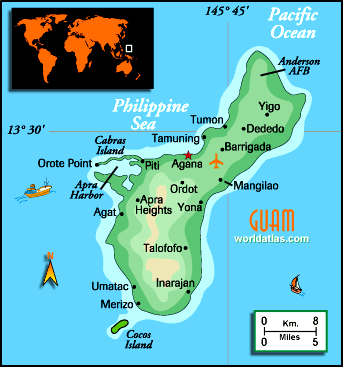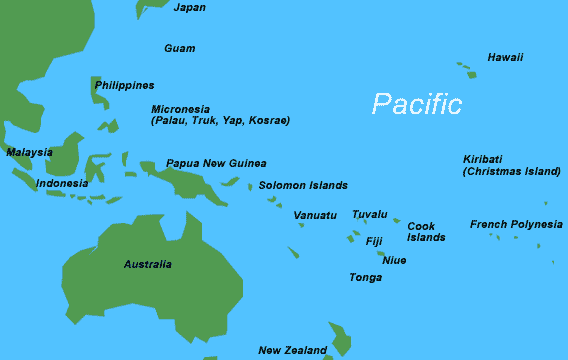
------------------------------------------------------------
America's Alarming Plan to Invite Japanese Troops to Guam
Why would the U.S. offer to allow Japan, a foreign power with a constitution that forbids such a thing, to station its forces on U.S. territory? According to this wide-ranging examination of the importance of Guam from China's State-controlled People's Daily, the answer is simple: by offering to station Japanese troops on its territory, Washington hopes to get Tokyo to pay for construction and moving costs. But the authors write that the plan worries surrounding countries, who fear that the move will encourage Japanese militarism.
By Qi Wu Xiaoming, Cheng Gangli and Cao Pengcheng
Translated By Haywood Ho
March 22, 2005
China - People's Daily - Original
Article (Chinese) 
 The Location of the Strategic Island of Guam (above and below)
The Location of the Strategic Island of Guam (above and below)
[ Guam]
Guam]

----------------------------------------------------------------------
Since the
Pentagon announced the eastward shift of its defense strategy, it surprises no one when
the U.S. military decides to send its aircraft carriers or submarines into the
Western Pacific. But for many, recent news of the U.S. Department of Defense's
invitation to Japan's Self Defense Forces [SDF] to be stationed in Guam came as
a bit of surprise. Guam is an Overseas Territory of the United States. It
certainly sounds strange when a superpower such as the U.S. invites foreign
troops to be stationed on their own soil. In addition, this also violates
Japan's pacifist constitution, and has sparked protesting from many Asian
nations.
PROVIDING
'ALL-WEATHER' SEA BASE
According
to a report in the Japan Times, an unnamed U.S. Defense Department official explained
that Washington had proposed the provision of facilities to Japanese forces on
Guam to be used as an "all-weather" training base, and extended an
invitation for an SDF Air Force squadron to station themselves there as well.
The
official said that the United States had included the cost of building these
facilities and moving American troops from Okinawa to Guam in the $10 billion price
tag, and has asked Japan to finance $7.5 billion of the cost with grants and
loans [It wants Japan to pay 75%].
This plan
allegedly emerged during talks between the U.S. and Japan over the redeployment
of the U.S. forces currently stationed in Japan. The United States and
Japan agreed at the meeting to increase SDF training opportunities on
Guam. The official said: "What we said to Japan then was, we welcome
your Army to come to Guam ... this is basically an all-weather
base. If you want to station an Air Force squadron or other things, we can
look into it and see if there's space at Anderson Air Force Base, and then we
can see if its possible to incorporate your needs into our plans (to redeploy American
troops)."
The
"Japan Times" Web site reported that it is remains uncertain whether
Japan will allow the SDF to take possession of a permanent overseas base, since
this is against Japan's peacetime constitution. Moreover, such a move is
sure to anger China and its other Asian neighbors, as many remain anxious about
Japanese military power.
WASHINGTON WANTS JAPAN TO PAY 75%
Why did the American Army invite Japan to station their troops in
Guam? The Japanese media believe that this is merely bait to get Japan to
pay for the costs of moving America's military base. America proposed
that Japan be responsible for 75% of the cost of moving the Okinawa base
to Guam, and building a new one there, and that this would require at least $7.5
billion. The government of Japan finds this difficult to accept, and the Japanese
people are unanimous in their objection. Many media outlets are outraged
at this, stating that the enhancement of U.S. military strength is the real
intention of this. Furthermore, stationing Japanese troops in American
military bases is also a significant development, and cannot be justified simply
by recounting, "America is responsible for Japan's defense, and thus Japan
should pay for it." They say that Japan is not merely a moving
company. At the same time, there are some in Japan who wish to "sit eye
to eye" with the American military, and who object to being relegated to moving
things and performing other second-rate activities for the U.S. military.
 View of Guam from the West Coast.
View of Guam from the West Coast.
[ Guam]
Guam]
-------------------------------------------------------------------------------
A senior
Chinese military colonel believes that even if America's Department of Defense opened
an all-weather military base for the SDF, it would have little substantial
military or strategic significance.
He says the U.S. move is directed at blunting the objections of
the Japanese people against building American military bases. Opening the
American military base on Guam and accepting Japanese forces or their planes, clearly
has this intent. "We (the Americans) agree to host Japanese forces
on our territory, so why do you (Japanese public) object to the stationing of
our troops on your land? So this was done to weaken sentiment against American
military bases, and to pressure the Japanese public.
Strategically,
America's offer will have no real effect on the SDF's combat abilities.
The colonel says that Japanese forces use mostly American equipment, receive
American-style training, and have trained with the American military for many
years, so its military structure should be fairly developed. Furthermore,
the U.S. Army has a large number of bases in Japan, and so has had plenty of time
to deploy new technology and train the SDF in their use. From this point
of view, there is little need for the U.S. to remove Japan's forces from Japan
for training.
UNLIKELY,
BUT WORTHY OF ATTENTION
International experts note that this is still just a proposal and that the U.S.
is a long way from actually codifying this with a legal document and passing such a
resolution in Congress. On the other hand, Japan has a government which
still refuses to acknowledge its historic crimes, and thus is not trusted by
many surrounding Asian nations. Thus, other countries would not like to
see the SDF encouraged to leave the confines of its own territory. If
America really takes this step, it will surely cause more discontent and
vigilance from other nations, and this type of foreign policy risk must be taken
into account.
At the
strategic level, military experts believe that such an arrangement, while
strengthening the Japan-U.S. military alliance, will encourage Japan in the
area of military affairs. But the psychological impact on surrounding nations
would be even more significant.
First of
all, this will strengthen the bonds between Japanese and American forces. Secondly,
the American army is now emphasizing the concept of a "Military Alliance Strategy"
precisely because the U.S. Army faces a quagmire in Iraq and is hoping to receive
help from its allies. And since Japan is its main East Asian ally, it is
natural that the U.S. would want Japan to share some of such a heavy
responsibility.
GUAM
IS SMALL BUT IMPORTANT
 --------------------------------------------------------------------------------------
--------------------------------------------------------------------------------------
Guam is
located in the southern end of Marianas Islands in the Pacific, and has excellent
natural defenses. The area of the island is 549 square kilometers
[212 square miles], is shaped like a long strip and is narrowest in the
middle. The topography of the island is high in the south, and low in the
north. The highest point on the island is at 405 meters [1,328 feet], and
it has a population of 154,600.
Guam is
in the heart of the Western Pacific. In an interview with the American
military newspaper "Stars and Stripes [ ]," the commander of the U.S. 7th
Fleet, Vice Admiral Jonathan W. Greenert, said: "If you look at a map of the Western Pacific
and use your fingers to draw a cross over the region we are responsible for,
you will see that at the intersection is Guam, so it is in a very strategically
important position. For this reason, Guam will always occupy a very
important strategic role." Air and sea traffic from the Far East,
Southeast Asia and Australasia must pass through Guam. In a recent U.S. Defense report that discusses the
world's sixteen most important sea lanes, four of them pass near Guam. Guam
lies 5,300 kilometers [3,300 miles] from Hawaii, and 2,500 kilometers [1,553
miles] from both Japan and Taiwan.
]," the commander of the U.S. 7th
Fleet, Vice Admiral Jonathan W. Greenert, said: "If you look at a map of the Western Pacific
and use your fingers to draw a cross over the region we are responsible for,
you will see that at the intersection is Guam, so it is in a very strategically
important position. For this reason, Guam will always occupy a very
important strategic role." Air and sea traffic from the Far East,
Southeast Asia and Australasia must pass through Guam. In a recent U.S. Defense report that discusses the
world's sixteen most important sea lanes, four of them pass near Guam. Guam
lies 5,300 kilometers [3,300 miles] from Hawaii, and 2,500 kilometers [1,553
miles] from both Japan and Taiwan.
 Vice Admiral Jonathan W. Greenert,
Vice Admiral Jonathan W. Greenert,
Commander of the U.S. Pacific Fleet.
[ United States 7th Fleet]
United States 7th Fleet]
--------------------------------------------
Ships leaving Guam can arrive in Japan,
the Philippines, Australia and the Strait of Malacca within four days (compared
to 20 days from the U.S. west coast). Fighter jets from Guam's Anderson
Air base can reach the Taiwan Straits in three hours, and reach the Korean
Peninsula in five. An officer at the Guam Air Base pointed out that the
strategic value of Guam was that forces stationed there were 14 hours closer to
Asia than any forces on any other American base. Since World War II, Guam
has been an integral supply station for the American military in the Indian
Ocean and the West Pacific.
WHAT KIND OF FORCES ARE POSITIONED ON GUAM?
Over
recent years, the U.S. military has built on a massive scale on Guam,
continuously upgrading the facilities of their bases, and deploying a large
number of strategic weapons. Guam has become the best-equipped core strategic
base in the Western Pacific. American forces on Guam have three large
bases, including the Apra Naval Air Station, the Apra Naval Facility and the
Anderson Air base. The headquarters for the 3rd Marine Expeditionary Division
is still under construction. When complete, it will cover more than 1/3 of
Guam's total area.
In the
budget submitted to the U.S. Congress by the Pentagon for fiscal year 2007, $15
million were included for building the Guam base. U.S. officials have
made no effort to conceal the continuous stationing of strategic aircraft and
submarines, with the aim of watching over conflict-prone areas of the Korean Peninsula
and the Taiwanese Strait.
 The B-1 Bomber: One of the Powerful Weapons
The B-1 Bomber: One of the Powerful Weapons
Systems Stationed in Guam.
-------------------------------------------------------------------------
Back in
2001, American and Taiwanese authorities secretly stationed Taiwanese F-16s on
Guam. The reason was that Taiwan's "Defense Department" Assessed
that, in view of the development of precision weapons by the People's
Liberation Army, the Hualien and Taitung air bases in eastern Taiwan were the
last line of defense against Chinese attack. Currently, Taiwan's advanced
AIM-120 medium-range air-to-air missiles are temporarily stationed there. Shortly
after the outbreak of the Iraq War In March 2003, Defense Secretary Donald
Rumsfeld and other Pentagon officials signed two "Force Reinforcement
Orders." One was for the U.S. to send 60,000 soldiers to the Gulf,
so that there would 300,000 American and British troops prepared to attack
Iraq; the other was for the U.S. military to deploy 24 B-1 and B-52 aircraft to
Guam in the Pacific, to deter North Korea from "robbing whilst there is a
fire."
Guam is a
U.S. dependency, and so military operations there do not require the consent of
foreign nations. Over recent years, bases in Japan and South Korea have
become increasingly unpopular with the population, and cries for the U.S.
military to leave have grown more strident. If, one day, the U.S.
military wished to launch military operations from a Japanese or Korean base,
not only would the process be lengthy, but there is the considerable
possibility that permission would be denied.
If the
situation were not handled well, the embarrassing episode in 2003, when the
Turkish government denied Washington the use of its territory to attack Iraq, could well be repeated. In Guam, not
only is there the freedom to deploy all types of weapons, but there is a option
of taking immediate military action, if such a need arises. Therefore, one
should be wary and cautious of the American military's proposal to allow
Japan's Self Defense Force to be stationed in Guam.
Chinese Version Below
五角大楼透出风声 美邀日本驻军关岛 意在分摊巨额军费 ●环球时报驻日本特派记者 曹鹏程 ●环球时报特约记者 冀孝齐 吴晓明 ●环球时报记者 程刚 李宏伟
关岛的美军安德森空军基地。
自从五角大楼宣布战略防务重心东移以来,美军现在无论向西太平洋地区增派航母还是潜艇都已经不足为奇了。不过,近日美国国防部提出邀请日本自卫队进驻 关岛,这个消息多少还是令人感到吃惊。关岛是美国的海外属地,邀请外国军队到自己的地盘上驻扎,这种邀约由身为超级大国的美国发出,令人感到非常陌生;而 对自卫队来说,此举无疑将违反日本的和平宪法,并遭到亚洲国家的强烈抗议。
提供全天候海上基地
据《日本时报》网站报道,美国国防部一位不愿透露姓名的官员近日在接受日本记者采访时称,美国已提议在关岛提供设施,作为日本自卫队训练的全天候基地,并将邀日本自卫队在这个基地驻军,其中包括一个空军中队。
这位官员说,美国已经把建设这些设施的费用纳入了美国海军陆战队从冲绳搬到关岛的100亿美元总开销中,并要求日本以拨款和贷款的方式出资75亿美元。
据称,这个建议是在美国和日本商量重新部署驻日美军的过程中提出的。美国和日本在会谈中同意增加日本自卫队在关岛训练的机会。这位官员说:当时我们对 日本说的是,欢迎你们的军队来到关岛
这基本上是一个全天候的基地。如果你们想在关岛停驻一个空军中队或其他东西,我们可以看看安德森空军基地哪儿有地 方,然后我们在规划整个(美军转移)计划中,会把你们的设施考虑进去。
《日本时报》网站的报道称,日本是否会决定让自卫队拥有一个永久性的海外驻地,现在还存在不确定性,因为这将违反日本的和平宪法;并说,此举也将惹怒中国和其他亚洲邻国,因为他们对日本的军事力量仍然感到担心。
美军想让日本出75亿美元
美军为什么会邀请日本到关岛驻军呢?日本媒体认为,所谓关岛的基地可以供自卫队驻兵,只是美军为了让日本出钱帮助美军基地搬迁,抛出的一个诱饵。美国提 出冲绳基地转移到关岛、以及在关岛建设新的军用设施等费用的75%要由日本负担,最少要75亿美元,这不仅令日本政府难以接受,民众更是反对声一片。不少 日本媒体对此义愤填膺,表示美国强化关岛军力有它自己的重要意义,而驻日美军基地对美国的世界战略同样功不可没,不能单纯强调美国负责日本防卫,日本负 责经费。它们说,日本并不是简单的搬家公司。同时,日本国内还有一部分势力希望与美军平起平坐,反对为美军担当运输和后勤管理。
中国军方的一位大校军官认为,就算美国国防部真的愿意在关岛开放一个全天候军事训练基地给日本自卫队,那也是作秀的成分大,谈不上有什么实质性的军事意义和战略意义。
他说,美国此举直接针对的是日本民间反对美军在当地设立军事基地的呼声。关岛的美军基地里辟出一个训练营地来接纳日本自卫队的人员或飞机,无非是表示, 我可以同意你日本的自卫队到我美国的地盘上呆着,为什么你日本老百姓要反对美国的军队驻扎到你那儿呢?这是希望借此弱化反对美军基地的公众情绪,给日本民 间施加压力。
在战术层面上,美国的这种举动对提高日本自卫队的作战能力并无实质意义。这位大校说,日本自卫队采用大量的美式装备,接 受美式战术培训,和美军协同演练已经很多年了,相应的各种军事体制已经非常成熟;另外,美军在日本固有的军事基地不少,可以有充裕的时间、足够的空间、部 署任何先进的设备来训练日本的自卫队。仅以这种意义论,美国完全没有必要把日本自卫队拉到关岛来训练。
可能性不大,但值得警惕
国际问题专家认为,目前,美邀日本到关岛驻军,还只是一个建议,真正把它变成法律文件,必须提出议案并在国会得到通过,现在离这一步显然还差得很远。另 外,日本有一个在历史问题上仍然坚持错误认识的政府,这样的国家还不能被周边的亚太国家所信任,因此,任何鼓励日本军事力量走出国境的行为都不为这一地区 的其他国家所乐见,美国若走出这一步,必将引起这些国家的不满和警惕,这种外交风险是不得不考虑的。
在战略层面上,军事专家认为,客 观地讲,这种具体安排有加强美日军事同盟关系的作用,对日本强化其在亚太的军事存在是一种鼓励。更多的影响体现在对相关国家的心理作用上。首先,这会提升 美日军事一体化的水平。其次,美军现在确实在强调联盟战略的理念,即因为美军在伊拉克陷入困境,很希望在其他地区能够得到盟国的帮助。而日本是美国在 东亚战略的主轴,美国期望日本帮它分担重任。
关岛虽小但很重要
关岛位于太平洋马里亚纳群岛南端,具有良好的自然驻泊条件。全岛面积549平方公里,呈长条形,腰部狭窄。地势南高北低,最高海拔405米左右,人口15.46万。
关岛处于西太平洋的心脏位置。美国第七舰队司令乔纳森·格林纳德中将在接受《星条旗报》采访时说:如果你从地图上看着西太平洋,用手指在我的战场责任 区内划个十字,你会发现交叉点就是关岛,它的地理位置十分重要。正因如此,关岛将永远在战略上处于重要的地位。关岛是远东、东南亚和澳大利亚的海空跨洋 交通必经之地。在美国宣布要控制的全球16个航道咽喉中,它就可扼守4个。它距离夏威夷5300公里,距离台湾、日本各2500公里。舰艇从这里起航,4 天即可抵达日本、菲律宾、澳大利亚和马六甲海峡,而从美国西海岸出发则需要20天以上。战机从关岛的安德森空军基地起飞,3小时即可到达台湾海峡,5小时 可到达朝鲜半岛。一名在关岛基地的美军军官指出,关岛的战略价值就在于,部署在那里的军队比任何其他美国基地的军队距离亚洲近了14个小时。二战结束 以后,关岛一直是美军在印度洋和西太平洋的综合补给站和中继站。
关岛的精兵强将对着谁
近年来,美军在关岛大兴土 木,不断完善基地设施,大量部署战略武器。目前,关岛已成为美军西太平洋基地中最大、设施最完善的战略核心基地。美军在关岛有阿普拉海军基地、阿加尼亚海 军航空站和安德森战略空军基地三大基地,还正在准备建设海军陆战队第三远征军的总部基地,占据了关岛总面积的1/3以上。
五角大楼向 国会提交的2007财年国防预算中,包括1500万美元的关岛基地建设预算。美军官员曾不讳言,不断在关岛屯驻战略军机和潜艇,目的是紧盯朝鲜和台海两个 潜在冲突区。早在2001年,美国和台湾当局就曾密谋把台F16战机驻在关岛。其原因是,台国防部评估认为,鉴于解放军发展精确武器,台湾东部花 莲、台东两处地下军事设施已非储存战力唯一屏障。目前台湾所采购的AIM120先进中程空对空导弹也暂定储存在该基地。而在2003年3月,伊拉克战争 爆发前不久,美国五角大楼官员向外界捅出了国防部长拉姆斯菲尔德签署的两条增兵令:一条说,美国将再向海湾发兵6万,从而使准备攻打伊拉克的美英军队 总数达到30万;另一条则讲,美军正在调派24架B1和B52远程轰炸机前往位于太平洋的关岛,以威慑朝鲜不要在伊拉克战争爆发时趁火打劫。
关岛是美国属地,在关岛的任何军事部署和作战行动,无须征得外国政府的同意。近年来,在日本、韩国的美军基地越来越不受当地民众的欢迎,要求美军撤离的 呼声持续高涨。如果真的有一天,美军要从日韩基地直接发动针对其他国家的作战行动,不但程序冗长,而且遭到拒绝的可能性也很大。弄得不好,2003年土耳 其政府拒不让美军从其境内攻击伊拉克的尴尬情形可能重演。而在关岛,不但部署的武器种类可以绝对自由,而且将来一旦需要,可随时发起作战行动。因此,美军 提出让日本自卫队进驻关岛,是一个值得警惕的动向。▲